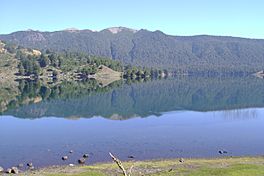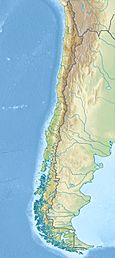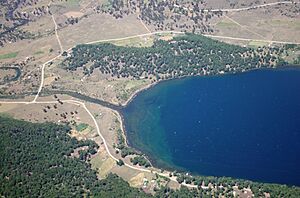Icalma Lake facts for kids
Quick facts for kids Icalma Lake |
|
|---|---|
 |
|
| Coordinates | 38°48′S 71°17′W / 38.800°S 71.283°W |
| Primary inflows | Huillinco and Icalma rivers |
| Primary outflows | Rukanuco River |
| Catchment area | 150 km2 (58 sq mi) |
| Basin countries | Chile |
| Max. length | 9 kilometres (5.6 mi) |
| Max. width | 2.5 kilometres (1.6 mi) |
| Surface area | 9.8 square kilometres (2,400 acres) |
| Average depth | 66 m (217 ft) |
| Max. depth | 135 m (443 ft) |
| Water volume | .6 cubic kilometres (490,000 acre⋅ft) |
| Surface elevation | 1,150 m (3,770 ft) |
Icalma Lake is a beautiful lake found in the Andes mountains of Chile. It was formed by glaciers long ago. You can find it in the La Araucanía Region.
Near the lake, there's a small village also called Icalma. About 3 kilometres (1.9 mi) from the village is a mountain pass, which is like a path through the mountains. This pass is called Icalma Pass and it sits on the border with Argentina. It's 1,307 metres (4,288 ft) high! A road goes through this pass, but it can be hard to use in winter because of heavy snow. There's also a small airport nearby, about 9 kilometres (5.6 mi) northeast of the village.
Icalma Lake is connected to a smaller lake called Laguna Chica de Icalma. They are linked by a short stream, only about 300 metres (980 ft) long. Together, these two lakes cover an area of 11.7 square kilometres (2,900 acres). Water flows out of Icalma Lake through a 10 kilometres (6.2 mi) long river called Rukanuco. Icalma Lake and another nearby lake, Galletué Lake, are actually where the big Bio Bio River begins!
Contents
Animals and Plants of Icalma Lake
Fish in the Lake
The most common fish you'll find in Icalma Lake is the brown trout. There are also rainbow trout living here. It's interesting to know that neither of these fish types are originally from Chile. They were brought here from other places.
Forests Around the Lake
The lake and the village are part of a special forest area called the Valdivian Temperate Rain Forest. This forest is known for its unique trees. The most famous tree here is the monkey-puzzle tree, which locals call "pehuen." It's a very distinctive and ancient-looking tree!
Climate Around Icalma Lake
The weather around Icalma Lake is known as an oceanic climate. This means it has mild summers and cool, humid winters.
| Climate data for Icalma | |||||||||||||
|---|---|---|---|---|---|---|---|---|---|---|---|---|---|
| Month | Jan | Feb | Mar | Apr | May | Jun | Jul | Aug | Sep | Oct | Nov | Dec | Year |
| Mean daily maximum °C (°F) | 24.3 (75.7) |
23.9 (75.0) |
21.3 (70.3) |
16.9 (62.4) |
11.4 (52.5) |
6.7 (44.1) |
6.6 (43.9) |
8.7 (47.7) |
12.5 (54.5) |
16.6 (61.9) |
19.5 (67.1) |
21.8 (71.2) |
16.0 (60.8) |
| Daily mean °C (°F) | 14.6 (58.3) |
14.1 (57.4) |
12.0 (53.6) |
8.6 (47.5) |
5.7 (42.3) |
3.6 (38.5) |
3.8 (38.8) |
4.5 (40.1) |
6.1 (43.0) |
8.5 (47.3) |
11.0 (51.8) |
13.0 (55.4) |
8.8 (47.8) |
| Mean daily minimum °C (°F) | 5.0 (41.0) |
4.3 (39.7) |
2.8 (37.0) |
0.4 (32.7) |
0.1 (32.2) |
0.4 (32.7) |
1.0 (33.8) |
0.4 (32.7) |
−0.2 (31.6) |
0.5 (32.9) |
2.5 (36.5) |
4.3 (39.7) |
1.6 (34.9) |
| Average precipitation mm (inches) | 28 (1.1) |
34 (1.3) |
64 (2.5) |
87 (3.4) |
200 (7.9) |
231 (9.1) |
218 (8.6) |
162 (6.4) |
99 (3.9) |
56 (2.2) |
61 (2.4) |
44 (1.7) |
1,284 (50.6) |
More to Explore
 In Spanish: Lago Icalma para niños
In Spanish: Lago Icalma para niños
- Llaima
- Sollipulli



